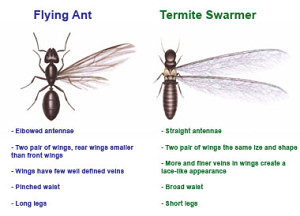Termite Swarmers
In the southern United States, particularly in regions with warm and humid climates, termite swarmers are a common phenomenon. Termite swarmers, also known as alates or reproductive termites, are winged adult termites whose primary purpose is to establish new colonies. These swarmers typically emerge in large numbers from existing termite colonies during specific times of the year, often in the spring or early summer, when conditions are favorable.
Here’s a breakdown of key points about termite swarmers in the southern United States:
- **Species**: The most common termite species found in the southern United States include subterranean termites, such as the Eastern subterranean termite (*Reticulitermes flavipes*), Formosan termite (*Coptotermes formosanus*), and drywood termites like the West Indian drywood termite (*Cryptotermes brevis*).
- **Life Cycle**: Termite colonies consist of various castes, including workers, soldiers, nymphs, and alates (or swarmers). The alates are the reproductive members of the colony. When conditions are right, usually after a period of rain and warmth, mature colonies release these swarmers in masses to mate and establish new colonies.
- **Swarming Behavior**: Termite swarms typically occur during specific times of the day, often in the morning or late afternoon. Swarmers are attracted to light and are often seen around windows, doors, or other sources of light. They are poor fliers and are easily affected by wind, so they may end up dropping to the ground or becoming trapped indoors.
- **Mating and Colony Establishment**: After swarming, male and female alates pair up and engage in a brief mating flight. Once they land, they shed their wings, find a suitable location, and establish a new colony. The female becomes the queen of the new colony, laying eggs to start the population.
- **Damage Potential**: While termite swarmers themselves do not cause damage to structures, they are a sign of an existing termite infestation nearby. Subterranean and drywood termites can cause significant damage to wooden structures, including homes, decks, and furniture, by feeding on cellulose material.
- **Prevention and Control**: To prevent termite infestations and reduce the likelihood of swarms, homeowners in the southern United States should take preventive measures such as maintaining proper ventilation and moisture control, keeping firewood and mulch away from the foundation, and scheduling regular termite inspections by pest control professionals. If an infestation is detected, various treatment options, including liquid termiticides, baits, and fumigation, may be employed to control the termites.

Overall, understanding the behavior of termite swarmers and taking proactive steps to prevent and control termite infestations are essential for homeowners in the southern United States to protect their properties from costly damage.
If you would like a FREE estimate for a Termite treatment for your home, call today.
Canton Termite & Pest Control 770-479-1598.
